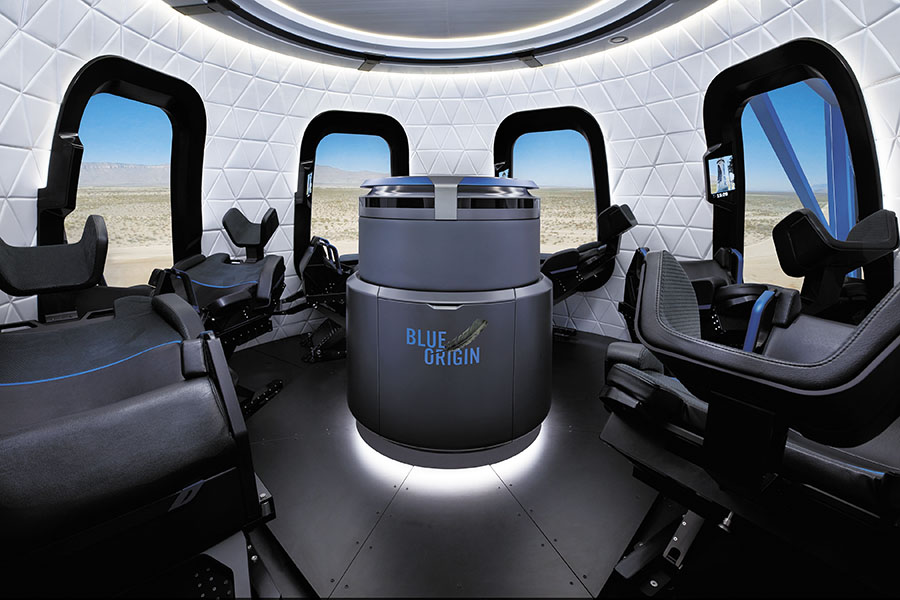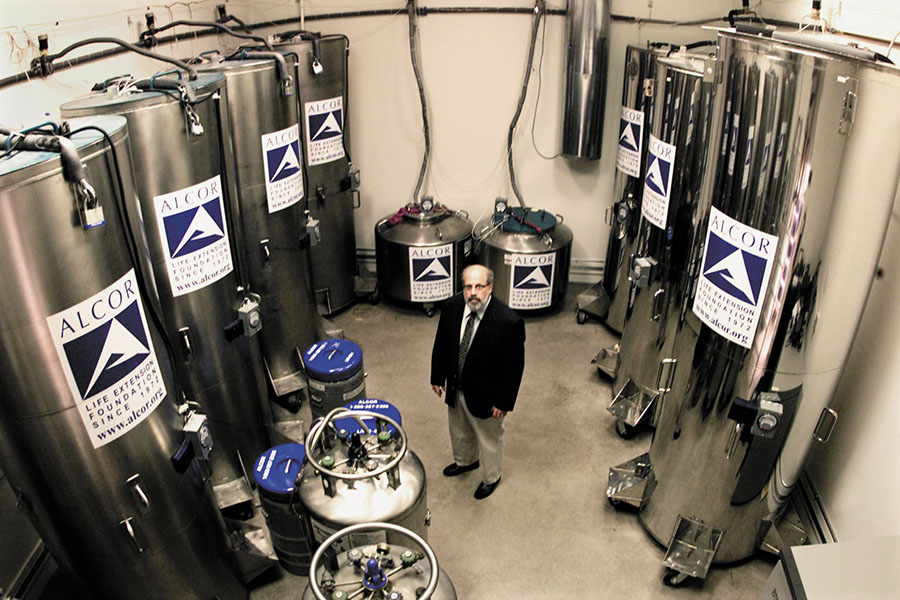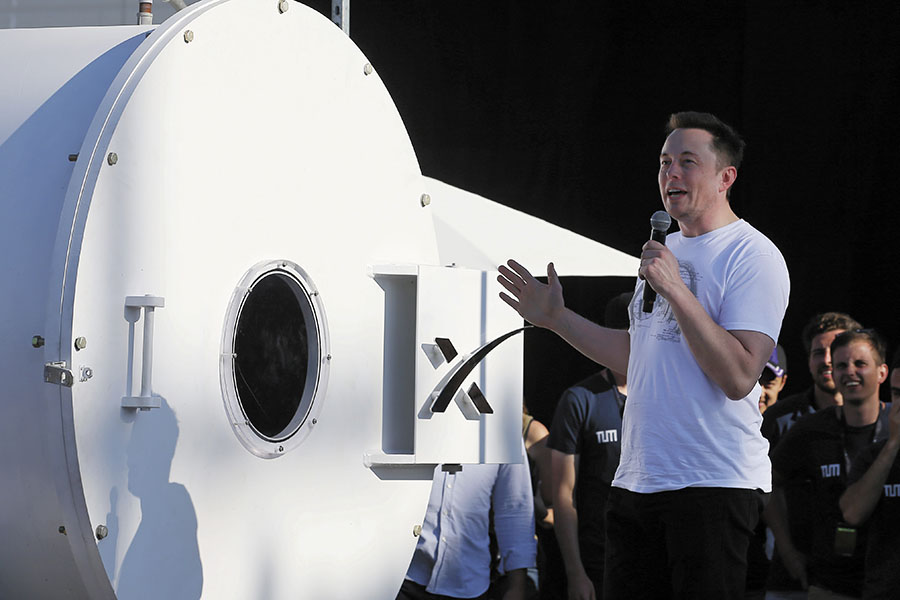
The new frontiers of indulgence
When, in the future, expensive baubles cease to hold the same novelty they do today, redefined concepts of luxury are what the super-rich can pick from

Image courtesy: Blue Origin
Things are, well, just that. Therefore, what might a billionaire or two, blessed with imagination, and the resources to follow through on that imagination, look for by way of the next big luxury indulgence?
It has to be something that goes beyond the idea of owning one more expensive object, yes? It must be the kind of luxury that makes getting there as important an aspect of the journey, as the eventual achievement itself. Here are three such indulgences that are redefining luxury.
Immortality
The quest for immortality has been eternal. Whether it is the Western ‘elixir of life’—believed to grant immortality, and cure all ailments—or the Indian mythological ‘amrit’, which emerged from the ocean, the search for the secret tonic has continued through millennia. But if immortality has been the key differentiator between the gods and mere mortals, then humans seem to be closing this gap, thanks to science and engineering.
The number of people who believe—based on data, not faith—that humans can become (almost) immortal is growing, and includes the likes of scientists, billionaires, engineers and billionaire-engineers. For instance, investor Peter Thiel has donated to the anti-ageing cause, in addition to the $500,000 (around ₹3.2 crore) Palo Alto Longevity Prize for anyone who can radically extend the life of a mammal. Larry Ellison, the co-founder of Oracle, too has donated $335 million to scientists studying ageing before he decided to redirect his foundation’s grants toward eliminating polio in 2013.
Unlike infectious diseases, which humans have learnt to prevent or treat with better nutrition and vaccines, threats such as cancer, dementia and stroke can be related to age. The MIT Technology Review quotes Felipe Sierra, director of the Division of Aging Biology at the National Institute on Aging, as saying, “I think we have failed in our effort to attack chronic disease when we attack them one by one… And the reason is that they have one major risk factor, which is the biology of ageing.”
Current scientific efforts range from attempts to make human beings more resilient to disease and ageing—thereby extending their natural lifespan—to preserving their bodies (after death) at very low temperatures so that one day they can be ‘woken up’.
David Botstein, Calico’s 74-year-old chief scientific officer, told MIT Technology Review, “What we are looking for, is to be able to contribute to a transformation like that [discovery of oncogenes that led to the first real understanding of cancerous tumours]… We’d like to find ways for people to have a longer and healthier life. But by how much, and how? Well, I don’t know.”
Since Calico’s backers are from among Google’s founders, the news got spun out into a story on the quest for immortality. Larry Page, who founded Google with Sergey Brin, however, only said that the venture would be “focussed on health, wellbeing and longevity”, in their 2013 Founders’ Letter to investors. Make what you will of that.

Image: Jeff Topping / Reuters
In the first category (of extending lifespans) is Calico—short for California Life Company—a biotech venture started by Google and Arthur D Levinson, former CEO and chairman of Genentech, in September 2013, and which, according to its press release, believes that ageing is the “most fundamental unsolved problem in biology”. Calico became a subsidiary of Alphabet Inc, Google’s parent company, when the search giant restructured its businesses in 2015.
Botstein added that, at best, it would be at least 10 years before Calico has anything to offer the world. That should not be a problem, since it is armed with a $1.5 billion R&D fund, in collaboration with AbbVie, a bio-pharmaceuticals company. The equal partnership involves a San Francisco facility that is “focussed on ageing and age-related diseases, including neurodegeneration and cancer”, the companies said in a statement in September 2014.
But gaining immortality can take different forms.
Those familiar with Indian mythology would know of the many stories of characters getting new heads or new bodies, or having the body of humans but heads of other animals. There’s Ganesh with his elephant head, Garud with his eagle’s beak and wings, or the twin Ashvins who had human bodies and horse heads.
This might all sound surreal, but real science isn’t far from it. The second kind of attempts towards gaining immortality accepts that it may not happen in the current lifetimes of most people. But, it could happen in the future. So, how about being able to ‘wake up’ in the future (after dying in the current life, of course), and getting another shot at a longer, perhaps better, life? The first step towards this would be preserving the dead’s bodies so that they can be woken up later.
Doing exactly this is Alcor Life Extension, a non-profit organisation in California, US, that has many members who have signed up to have themselves preserved cryogenically. Among the organisation’s 1,600-plus members are scientists, engineers, businessmen, actors, writers, singers and also financial planners.
These members are people who’ve agreed to shell out as much as $200,000 for their whole bodies to be preserved after what they see as ‘legal death’. But if you are not that rich, you could opt for just preserving your head for half the amount (and hope that a suitable body can either be found or be made for you in the future).
Alcor aims to first prepare a person’s body as soon as it can after the person has died, and then preserve the body in a container filled with liquid nitrogen. The preserved dead are called “patients”.
The idea is that one day, science and technology in related fields will advance to such an extent that Alcor will be able to resurrect these people. The hope is that even their memories might be intact, so that when they are made alive again, they might even remember that they had signed up for the preservation and the reasons for it.

Image: Mike Blake / Reuters
Space riders
Breaking boundaries and finding new frontiers to explore, driven by an insatiable curiosity, is another characteristic that defines us as humans, and space has fascinated us for as long as we can remember. This makes a seat in a capsule that will take people out of the earth’s bounds, even briefly, a genuine luxury that only the ultra-rich can afford.
It is an experience that costs millions of dollars, afforded only to a handful of astronauts—who’ve trained much of their adult lives for such expeditions—in government-funded space flights. But if companies such as SpaceX and Virgin Galactic succeed, as their billionaire founders Elon Musk and Richard Branson plan, private citizens of various countries might also get a chance. Very rich private citizens, of course.
Virgin Galactic is currently testing its SpaceShipTwo spacecraft, which the company expects to commercialise in 2018, carrying payloads as well as tourists. The plan initially is to do ‘sub-orbital’ flights, which means the spaceship will go out into space for a bit, but will re-enter the earth’s atmosphere without making a full-orbit journey around the planet. The whole flight—takeoff to touchdown—is expected to last about 2.5 hours, with the weightlessness lasting only about 6 minutes.
According to the company website, the roughly 700 Virgin Galactic future passengers who have already paid deposits for their flights on SpaceShipTwo come from more than 50 countries, half of which have never sent a human to space before. These passengers range in age from under 10 years to over 90 years.
Initial buyers were charged $200,000, but the fee was bumped up to $250,000 about four years ago. Among those who have signed up are scientist Stephen Hawking, actor Tom Hanks and singer Katy Perry.
A more ambitious space tourism effort is under way at billionaire Elon Musk’s company SpaceX to take two private astronauts on a jaunt around the moon. And, that too, as early as 2018. “SpaceX has been approached to fly two private citizens on a trip around the moon late next year. They have already paid a significant deposit to do a moon mission,” the company said in a statement this February, announcing the plan. “Like the Apollo astronauts before them, these individuals will travel into space carrying the hopes and dreams of all humankind, driven by the universal human spirit of exploration.”
SpaceX, however, has not named the two potential private astronauts. “We expect to conduct health and fitness tests, as well as begin initial training later this year,” the statement adds. The company expects to use its Falcon Heavy rocket for the flight, which will carry its Dragon spacecraft. SpaceX is already doing ‘non-crew’ flights with its rockets and spacecraft for the US’s national space agency Nasa.
Musk and Branson aren’t the only billionaires with deep interest in (and pockets for) space exploration. Jeff Bezos, founder and CEO of ecommerce giant Amazon is another. This March, Bezos revealed the concept of what his space company Blue Origin was building, by way of a space module: It had seats, padded walls and handles all over for astronauts to use in zero gravity and large windows, so the views would truly be worth the money. Bezos, who is investing his personal wealth in Blue Origin, by selling Amazon stock, is also building a rocket for which he already has customers signed up.
SpaceX also has a longer term goal for its Dragon spacecraft, which the company pointed to in its February statement: “Designed from the beginning to carry humans, the Dragon spacecraft already has a long flight heritage. These missions will build upon that heritage, extending it to deep space missions, an important milestone as we work towards our ultimate goal of transporting humans to Mars.”

Make-your-own islands
For those super-rich individuals who do not want to leave Earth behind, there will be ways to make their stay on the home planet even more luxurious.
For instance, instead of owning private islands—so far considered one of the hallmarks of super-rich status—they would be able to go a step further and customise these islands.
For the super-rich, all of this is possible, says Amillarah Private Islands, a company registered in the Netherlands, which is in the business of building such islands. “Not only can you customise the size, shape and style of your luxurious floating residence, but you can also pick where you want it to be located. Miami? Maldives? Dubai? New York? The choice is yours,” the company says on its website, complete with a YouTube video of a tiny tropical island, with palm trees et al. Prices start at $10 million.
Amillarah’s luxury, floating islands are built by Dutch Docklands, the company says, because “for hundreds of years the Dutch people have led the world in water defence technology”.
The company collaborates with Christie’s International Real Estate, and oceanographer Jean-Michel Cousteau’s Ocean Futures Society to design and build the islands.
The designs come from Koen Olthuis, a Dutch architect specialising in floating structures, who made it to the 2007 Time magazine’s Most Influential People list.
He has started a company called Water Studio and has co-authored a book titled (what else) Float.
(This story appears in the 13 October, 2017 issue of Forbes India. To visit our Archives, click here.)
Post Your Comment















